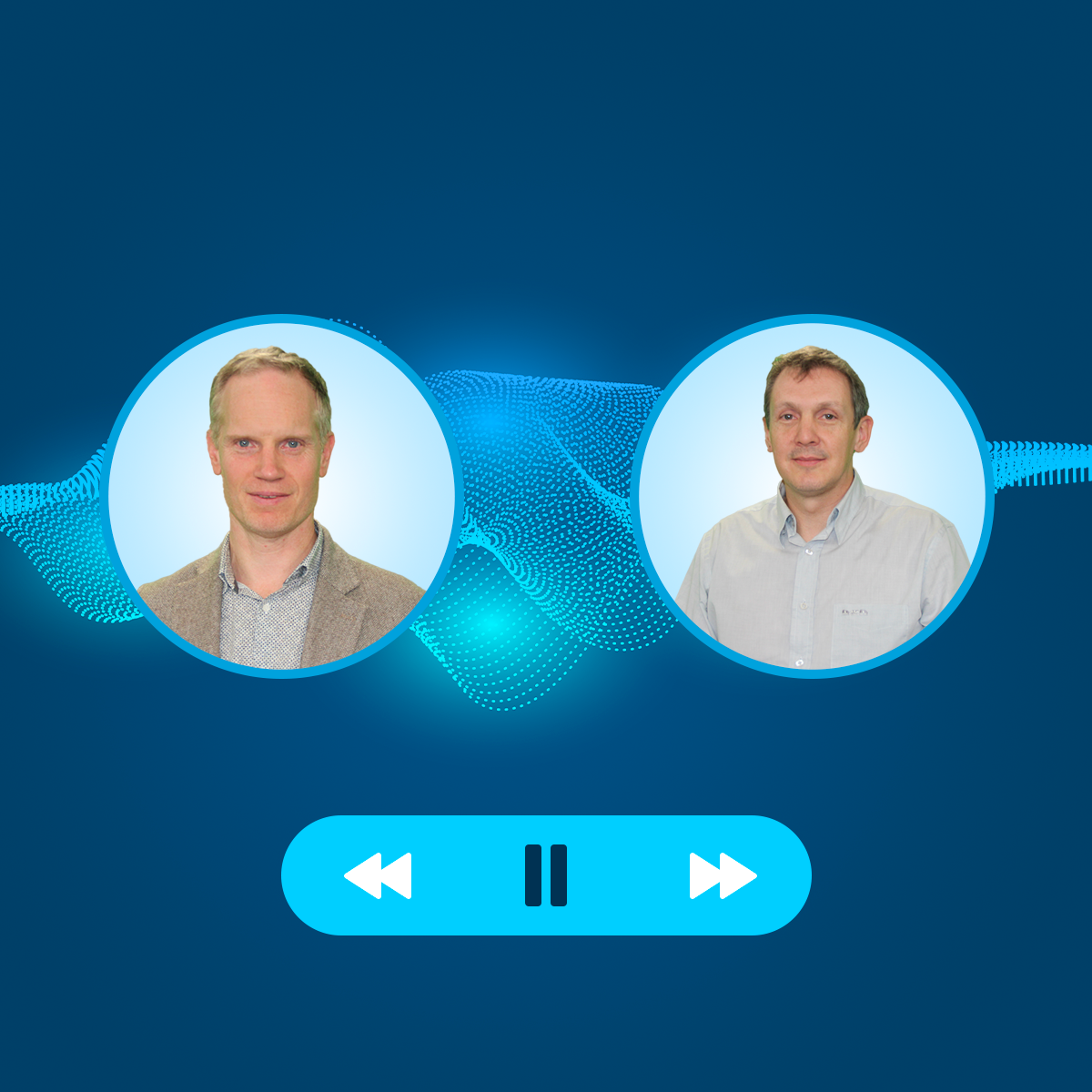Cloud & SaaS Solutions: Fundamentals and Upcoming Trends
Learn all there is to know about the benefits of cloud and SaaS solutions with Dassault Systèmes experts Vincent Frèrebeau and Sébastien West.
Designing Impactful Innovation podcast - episode 19
In this episode, two Dassault Systèmes experts share their expertise about cloud and software-as-a-service (SaaS) solutions. What is the difference between SaaS and cloud? How has public perception of these solutions evolved? How safe is it to switch to the cloud? What can high-performance computing and cloud sovereignty do for businesses?
Tune in with Vincent Frèrebeau, vice president of online store and cloud adoption, and Sébastien West, worldwide value engagement cloud and infrastructure director to find out.
Meet our speakers

For new companies, for startups, clearly it's not even an option to choose something else than going on cloud.

To process particularly sensitive data in a secure environment, and again, immune to any extraterritorial laws, more and more customers are requesting sovereign environments.
You can follow the "Designing Impactful Innovation" podcast on Apple podcasts, Spotify, Deezer, YouTube or by RSS.
Stay tuned!
Read the transcript
Clara: Hello and welcome to Designing Impactful Innovation. I'm your host, Clara, and today, we're talking about trends and challenges in cloud and SaaS solutions with two Dassault Systèmes experts, Vincent Frèrebeau, vice president of online store and cloud adoption, and Sébastien West, worldwide value engagement cloud and infrastructure director.
Hello, Vincent and Sébastien, welcome to the podcast! Thank you for joining us today. Before we begin, could you please introduce yourselves for our listeners?
Vincent: Sure. On my side, I'm Vincent Frèrebeau, and I'm in charge of what we call the online store of Dassault Systèmes – capacity for clients to buy online and cloud adoption, which means how do our clients adopt our solutions on the cloud.
Sébastien: And I'm Sébastien West, worldwide value engagement cloud and infrastructure director. Happy to be with you, Vincent, today. On my side my mission and the mission of my team is to support large engagement on cloud, and especially for very large customers.
Sébastien: Okay, so I want to start. Cloud computing and software as a service are related concepts, but they refer to different aspects of technology.
To simplify, cloud computing is an adoption of three layers: infrastructure as a service, platform as a service and software as a service. The most common way to move to cloud for our customers is to use infrastructure as a service.
Thanks to cloud providers, it's very easy to deploy servers in many locations around the world. On this layer, it's still under the customer’s responsibility to manage very low-level components like operating system, database, network, configuration, and to pay each time their usage of this component.
At the opposite, on a full SaaS approach, all the responsibilities are fully covered by the SaaS provider. And at the end, for the customer, the main benefit is: always up to date, always on, everywhere, without any high-level IT complexity. So, I wanted to summarize the fact that, from my point of view, the SaaS is a real target of every move to cloud approach.
So, for Dassault Systèmes, cloud is a synonym of software as a service, and it's allowing to deliver more to our customers, more quickly.
Vincent: I agree with you, Sébastien. If I'm looking at it from a client perspective, client point of view, I would say that they don't see the software editor in the same way. If it's cloud, they see it as a supplier, as a provider of services. It could be infrastructure as a service, indeed, as you said.
Whereas if they buy something on SaaS, software as a service, the software editor becomes a partner. The software editor has to take care of everything, so all the burden, all the difficulties from an IS standpoint relies on the software editor. So it's a very strong relationship that at Dassault Systèmes, we have to establish with our clients when they choose to subscribe to our software as a service.
Sébastien: I agree. It's a clear change of mindset and we have a great opportunity to discuss again about this point.
Clara: Now that we're all on the same page, I wanted to ask you about public perception of cloud solutions.
Vincent: Yes, since I’ve followed the trend of cloud since almost 10 years, I have seen really, the progress on that.
I would say that, for most of the companies, it's not a debate anymore. There's no debate, even internally. For new companies, for startups, clearly it's not even an option to choose something else than going on cloud. They are very used to such models, business models of subscription. The engagements they have with all their partners are in their subscription model, whether it is for software or even for any other engagement. And when we discuss with them, it's a given.
For larger companies, and I guess Sébastien will tell us more about that, the question is not anymore why to go on cloud, it's more when to go. And as you said, it's a roadmap. It's a step approach. And globally, they move to cloud when everything is ready from a migration standpoint – how do they migrate the process, their training, the data and this is the choice that they have to make.
Sébastien: Yeah, agree, it’s no more a question. But I think we can see an evolution in term of mindset. At the beginning, we heard a lot about a move from CAPEX to OPEX – a move from a large investment to more pay-as-you-go. And it's really a way to use very large capabilities of compute, a lot of very powerful servers without a large investment.
What we can see today is that our customers want to delegate, not only the maintenance of the physical server and network, but the level of delegation is much higher. Operating system, database, application server, cybersecurity – progressively, they don't want to manage this layer and they want really to be focused only on the application layer to make their own business.
More and more, they are focusing on the availability of the application, the total cost of ownership, and the go to market, so the speed to deploy new solutions. And more recently, they are really focused on cybersecurity.
Clara: Right, so we have different perspectives from small businesses and large companies, a change of mindset and companies that want to delegate. Delegate is what I've heard a lot – the maintenance, for example.
Security remains a concern for many clients, and you talked about cybersecurity. “What if someone hacks my data? If I don't have control over where it is, then how do I know that it's safe?” are things that we've heard before.
Vincent: I think, indeed, the, perception on the security has evolved as well and there are less concerns from most of the companies because they understand that they cannot reach the same level of security than a software editor would have, at least for the same investment.
And for them, it's good to rely on a partner when they engage, again, on a software as a service, on a partner who has a skill. When we rely on 3DS OUTSCALE or AWS, of course, it's at the core of their business to look at the security. And they understand that they could not afford the same level of security if they were investing themselves.
And on top of that, I think the best way to answer is by being compliant with security rules. There are rules per country, there are rules per industry, compliancy rules, and as long as we are compliant with those rules it's the best effect we can have on this perception.
Sébastien: Yes, I agree. I think there is another point and another type of difference between cloud and SaaS. When we are considering a very classic move to cloud approach, just by moving an application located on a customer data center to a server on the cloud, it's probably not the best solution to guarantee cybersecurity. From a server inside the customer network to a server on the cloud, directly open to Internet, I can easily understand why some companies are afraid about the risk of cyber-attacks.
A lot of them, during this lift and shift approach, increase potentially the level of risk. Because they need to maintain by themselves every component. Again, they need to patch operating system, install a firewall, and each time a vulnerability is discovered, they need to fix it when they are using applications on a cloud provider and a classic hyperscaler. Because it's not the work of infrastructure as a service provider to do that.
On the other side, again, a complete SaaS approach allows to avoid any question of responsibility between the provider of an application, the provider of the operating system, or the provider of any other component.
On a SaaS approach, the SaaS provider knows perfectly which component it is using, and where, and when potentially a vulnerability is discovered, it can fix it. And we are speaking at Dassault Systèmes about DevSecOps approach, and thanks to that, a SaaS provider like Dassault Systèmes can fix every vulnerability as soon as it's discovered.
I think the best proof point in terms of level of trust allowed by our SaaS solution is the fact that companies from very sensitive sectors like aerospace and defense are now more and more engaging with our SaaS solution.
Clara: To summarize, Cloud and SaaS enable a better return on investment, better compliancy with security regulations, and providers can give a greater level of security than what on-premise do on their side, right?
Vincent: Yeah, because they have to manage the whole chain of security aspect and the whole delivery. Again, it's about being focused on its core competencies. So, providers, it's their work to do that at the heart of the delivery they have and the value they bring to their clients. Whereas if you delegate that to each of our clients, they will have less focus on it because it's not the core product that they have to develop.
Vincent: If I look at it from, again, our clients’ point of view, it's different usages that we have seen. Now that they can focus on their product, developing their product, their innovations – we have, two main evolutions in their usage.
The first one: it's the fact that they do more and more online work, online collaboration, online engagement. They look at the best software to purchase online because they replicate what they are doing on their daily life, outside of their professional life. And so they rely on others’ recommendations to make decisions.
They are more autonomous in the way they engage. So for purchasing, for training for sharing, I would say there's clearly a shift to engage more and more directly online.
The second trend I have observed is the capacity for our users to lower the computing capacity that they have on site. Typically, there are more and more of our users on Chrome, on very low-end devices because they rely much more on cloud computing. They rely on the capacity which is on server. They tend to prevent from installing software locally and run as much as possible web applications.
The cloud and the infrastructure part of the cloud, the infrastructure as a service, bring that capacity to have a very high computation capacity on the server and lower the capacity of the client’s side. So, it's another trend I've been able to observe.
Sébastien: Yeah, on my side, I can see globally three different ways of SaaS and cloud deployment.
So first of all, a worldwide usage allowing every company to increase the level of collaboration inside the company, and especially when they are located all over the world. So clearly, I see a better international collaboration usage. So inside companies, but also between companies, large companies and their partners and suppliers.
The second main trend is that I see more and more questions of sovereignty and compliance. Sovereignty because companies want to process particularly critical data or intellectual property in a secure environment immune to any extraterritorial laws.
And compliance because they must respect industrial norms like TISAX for the German automotive industry or GXP for life science or healthcare companies. So they need to be compliant with those norms, so we need at Dassault Systèmes to help them to demonstrate that they can be compliant with all of them.
And the last trend: more recently, every company wants to take benefit of the cloud approach, including companies managing data with the highest level of criticality, like cities and the aerospace and defense industry.
And that's something really new. So, they need to be fully related, but they want to take benefit of cloud. Globally, for this last category, we are speaking more about dedicated cloud, fully isolated. If I have to summarize in three words, trends are international, sovereign, and dedicated cloud.
Vincent: It's something that started many years ago. In fact, now in our data center, we are able to grow the capacity, the power which is distributed thanks to the infrastructure as a service. And step by step we can see that, our clients, they rely a lot on that high performance computing for visualization first because they work remotely but more and more as well for simulation capacity.
And it's something that is very useful for small and medium companies as well as startups. When they are developing a new product, a new project, they need to demonstrate that it's viable. So they usually need to demonstrate that prior to get some financial funding to really produce their products.
And thanks to the high-performance computing, they are able to rent, to subscribe, on a short period of time to very high capacity and run those simulations to be able to demonstrate that to the investment fund.
Sébastien: Yes, I think that this topic is really very good news for a lot of companies, and especially small and medium businesses. Part of the software-as-a-service offering is that there is more and more simulation capabilities.
So in the past, every company needed to invest in a lot of servers, HPC. The cost was really huge, and it’s only available for very large companies. More and more simulation capabilities are part of software-as-a-service solutions. And companies can include simulation capabilities on top of manufacturing or CAD capabilities.
Additionally, the flexibility of the cloud platform allows engineers to adapt and change simulation requirements and scenarios very easily. Again, without investing a lot in terms of hardware on their side, they can start very small and grow very quick. That's really, from my point of view, very good news for every company and especially when they can't have their own HPC.
Clara: So yeah, it enables a lot of different capabilities. Sébastien, you also talked about cloud sovereignty.
Sébastien: In fact, to process particularly sensitive data in a secure environment, and again, immune to any extraterritorial laws, more and more customers are requesting sovereign environments.
They want really to protect their data in cloud, and some countries already defined some standards. With a high level of requirement in terms of cybersecurity and transparency regarding shareholders and data center location. So that's really a such type of topic we should consider when you're speaking about sovereign cloud.
The European Union has been actively working on this topic. And various other countries have introduced their own standard or framework. At Dassault Systèmes, thanks to our 3DS OUTSCALE brand, we can provide the 3DEXPERIENCE platform on a cloud region which is fully qualified on SecNumCloud by the French National Agency for the Security of Information Systems, which is probably one of the highest level of requirements in all Europe, and potentially in the world.
Vincent: If you remember well, Sébastien, we were already working on the cloud when the Cloud Act was created in the US. I think it was in 2018, something like that. And it's really where this notion of sovereign cloud started to come in each and every discussion we had with our clients.
Because the Cloud Act, this is what you are mentioning about the laws in other countries. And so many European countries, but not only – it's true in Asia as well – have decided to focus some of their industries on sovereign cloud. And this is the strategy that we have adopted as well at Dassault Systèmes.
Sébastien: Yes, I think that there is no more project and large engagement without discussion about sovereignty, what are the sovereignty attributes. Potentially, we can see some sample location of data, citizenship of operators. That's really some topics we are discussing with every large customer.
Vincent: And as well in all the projects mixing private companies and public sector. Whatever the industry, it's always on a sovereign cloud that we have to perform that.
Sébastien: Agreed.
Clara: Well, this was a fascinating topic, and there’s so much more to talk about, so you'll definitely have to come back to tell us more. Thank you again for joining us today, Sébastien and Vincent!
Sébastien: Thank you.
Vincent: Thank you.
Clara: Make sure to stay tuned. Sébastien and Vincent will be joining us again in our next episode, where we'll be focusing on the benefits of cloud and SaaS solutions for startups.
In the meantime, you can find more information on our website, 3ds.com/cloud. Don't forget to subscribe for more insights and stories from our guest experts.
Learn more
Ready to learn more?
See how the 3DEXPERIENCE platform on the cloud can transform your business. Fill out the form to get in touch with our experts.





